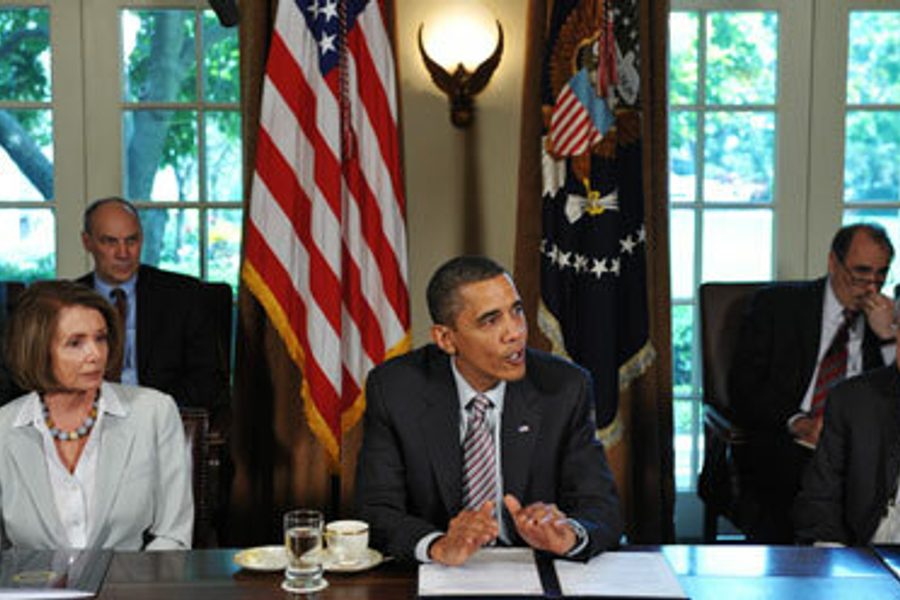
With the Senate still dithering over extending unemployment to those eligible for it while over 25 million workers are unemployed or under-employed, this week saw even more bad news for progressives and labor activists.
Democrats are in control of both houses of Congress and the White House, so the continuing official joblessness of nearly 10 percent that’s made this “recovery” so anemic endangers Democratic prospects to retain the House, and, possibly, even the Senate. President Obama’s approval ratings have never been worse, with nearly 60 percent of the public having little or no trust in him.
And now, with two million people losing their benefits in the last several weeks of stalemate over unemployment benefits, the economy could be headed toward another “double-dip” recession, even as millions are still scrambling for any kind of work. “The economy is still in the gravitational pull of the Great Recession. All the booster rockets for getting us beyond it are failing,” says Robert Reich, the former Secretary of Labor.
How to get out of this political and economic tailspin is spurring soul-searching by progressives — and efforts by labor, via online and modest grass-roots organizing, to stir support for ambitious jobs measures that are going nowhere fast in the Senate.
Meanwhile, Speaker of the House Nancy Pelosi is reportedly attacking White House spokesman Robert Gibbs for indifferently badmouthing Democratic chances to retain their House majority. And there’s no coordinated political messaging or policy initiatives underway that can jump-start the economy before the Novemeber election, so Democrats are left stranded without any realistic plan for success.
Take, for instance, a recent action alert sent out by the AFL-CIO calling for Senators to take action on a to-do list of urgent economic measures. The only items that, at this point, seem to have a decent chance are watered-down financial reform and some short-term extension of jobless benefits for the unemployed. But the long-term unemployed who have lost their 99 weeks of benefits have essentially been abandoned by the Obama administration, Democrats and the Congress.
Here’s the AFL-CIO do-do list that included saving 900,000 government jobs, but there’s no political will to push such measures through, let alone the broader $400 billion packages for direct jobs creation labor was promoting several months ago.
Now Obama’s original coalition of young people, single women and minorities is being especially hurt by unemployment, further endangering his chances, as Eric Lotke of the Campaign for America’s Future (CAF) observes:
The progressive movement that fueled Obama’s stunning 2008 election victory is out of work. Sure, lots of people are unemployed — but the demographic groups at the heart of the Obama coalition have been hit especially hard. That’s why it’s so bitter to watch Obama be so passive on the economy. He is meekly awaiting the upturn as if patience will be rewarded, and he has adopted many of the right-wing talking points that got us into the mess.
Okay, we’re happy with what we have. The Recovery Act provided the only light in the tunnel, and health care reform will kick in someday. But we want more. We want the political alignment to reflect our wins.
Obama won the national election with 53 percent of the vote compared to McCain’s 46 percent, a margin of seven percentage points. Unsurprisingly, he carried African Americans by a 91 point margin (95 to 4) and women by a 13 point margin (56 to 43). But that’s not all. The political coalition that carried him to victory is the wave of the future. Hispanics voted for Obama by 36 percentage points (67 to 31). Youth under thirty — many voting for the first time, and all of them eligible for decades into the future — voted for Obama by a 34 percentage point margin (66 to 32). White youth chose Obama over McCain by ten points (54 to 44). The Obama coalition could be a progressive coalition for a generation to come.
But he seems to have abandoned them. Obama’s people care about jobs but Obama talks about deficits. The Democratic base needs work but the Democrats can’t muster enough votes to extend unemployment benefits or aid to the states to avoid layoffs of teachers and firefighters. Our progressive coalition is ready to fight, but Obama seems more intent on making friends with his enemies (AKA bipartisanship) than making friends with his friends.
And now, while the progressive jobs message is floundering, the Chamber of Commerce and its allies are stepping up with a new “jobs” campaign that aims to lure Americans enraged by the current failures — even if they’re selling the same old elixir of less regulation and lower taxes that got us into this economic mess.
Who possibly could be fooled by these arguments? Well, how about the voters who are flocking to Republican challengers in Senate races, including in Nevada and California, that make it seem possible now that Democrats could even lose the Senate—let alone the House, as Robert Gibbs said over the weekend, enraging House Democrats over the White House’s lukewarm support.
And, thanks to the Citizens United decision allowing unlimited corporate spending on campaign ads, businesses and trade groups will now have hundreds of millions, if not billions, at their disposal to destroy any progressive Democrats who seeks to promote spending on jobs or the taxation or regulation of businesses.
In that context, Obama’s logical but uncompelling argument that the original stimulus created more than 3 million new jobs, and that we would have been worse off if Republicans were in power, won’t be enough to generate high turnout or higher approval numbers.
Still, it’s worth fighting for a long-shot progressive agenda, CAF’s Robert Borosage argues:
The conservative noise machine already argues that the President, having run up record deficits with a failed stimulus program, now wants more of the same. Virtually all of these measures will be opposed - as everything else has been - by Republicans. Little of it will survive the inevitable Republican filibuster in the Senate.
Why propose what is unlikely to pass? Because these measures are needed, and at least will clearly define the choice for this fall. Why propose measures that will increase the deficit that people are said to be freaked out about? Because the majority of Americans, if forced to choose, make the right choice - for focus on jobs over deficits. So pose the choice between a White House and Democratic Congress still pushing for action on jobs, and an opposition focused on deficits and wedded to the policies that drove us off of the cliff.






